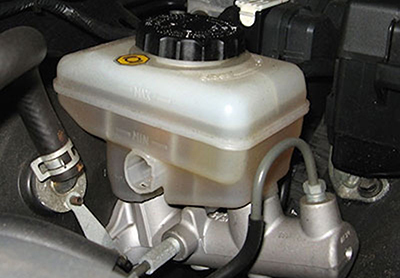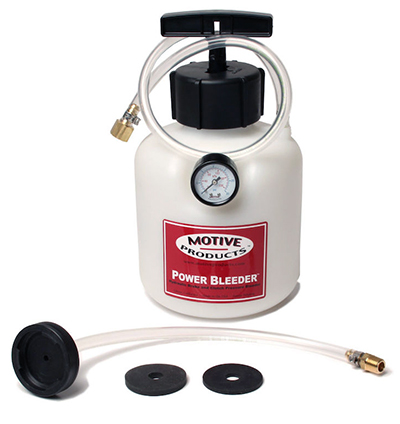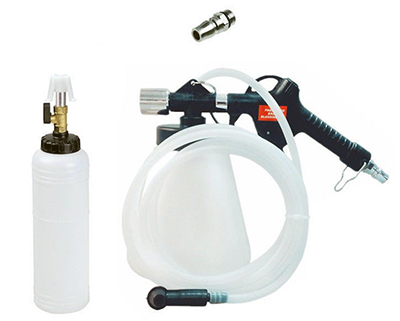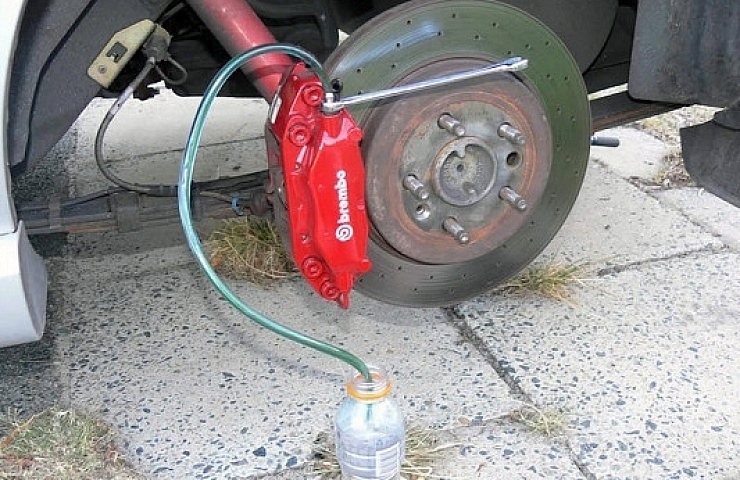Contents
Many basic car maintenance tasks used to be required every 5,000 miles. But thanks to modern engineering, most can now wait as long as 100,000 miles. One exception is the need to check your brake fluid at least every two years—or even sooner if you put on a lot of miles.
So if a visual inspection (or use of a test strip) reveals that it’s time to top off or change your brake fluid, fear not. It’s one of the easiest automotive DIY tasks.
Prep Work
First, locate the transparent plastic brake-fluid reservoir in the engine compartment. You will see hash marks for minimum and maximum levels. If the level is low, it’s time to add brake fluid. Whether you are adding or completely replacing your brake fluid, always refer to your owner’s manual for one of these specific recommended types:

The master cylinder reservoir holds your vehicle’s brake fluid.
You must only use the specified type of brake fluid and don’t mix the different types. Also, take heed: Brake fluid is highly corrosive to painted surfaces. Place a clean rag near your workspaces to avoid spills. Immediately wipe off any brake fluid that gets on your paint.
Bleeding Your Brakes
The process of purging the old brake fluid from the system—or removing the air bubbles from the line—is called “bleeding” your brakes.
Today’s vehicles have individual brake lines that carry the fluid from the master cylinder to each wheel’s brake caliper. You can push, pull, or pump the fresh fluid from the master cylinder to each brake caliper. This process is repeated for each wheel, starting from the farthest (usually the right rear wheel) to the closest wheel (the left front wheel). Check your owner’s manual because ABS systems might have different brake bleeding patterns.
Here’s a nifty trick to make it go faster. Before starting the bleeding process, use a common turkey baster to suck out as much old fluid as possible from the master cylinder reservoir.
Push the Brake Fluid
We highly recommend using a power brake bleeder to replace the old brake fluid with new fluid. This device consists of a tank with a hand pump similar to a pressure sprayer. First, fill the bleeder tank with fresh brake fluid, attach its hose to the master cylinder reservoir, and pump up the tank to about seven to 10 psi.
Shop now for a power brake bleeder

A power bleeder pushes fluid out of the system.
Raise your vehicle one wheel at a time and secure it with jack stands. Then remove the wheel to get to the brake caliper and find the brake-bleed nipple on the caliper. Next, connect a piece of clear plastic hose to the caliper to drain the old fluid into a jar or can.
Using a small wrench, open the nipple slowly, and watch the fluid as it comes out. As the brake fluid moves out, you might see air bubbles, little pieces of rust, or other debris. When the brake fluid becomes clear, that line and caliper have new brake fluid. Repeat the process for the other three wheels.
Finally, take your used brake fluid to a recycling center.
Or Pull Your Brake Fluid

A vacuum brake bleeder sucks the fluid from the master cylinder reserve.
Pulling the brake fluid into each caliper is an alternative replacement process. You can suck the brake fluid from the master cylinder reservoir with a vacuum brake bleeder. As with the push process, you will push out the old brake fluid one wheel at a time. The only downside is the need to ensure that the master cylinder reservoir has enough brake fluid as you move from wheel to wheel.
Shop now for a vacuum brake bleederBoth the push and pull methods are easy ways to change your brake fluid without any assistance from a helper.
The Old-School Two-Person Method
If you don’t have (or want to invest in) a pressure or vacuum tool, you can go the old-school route with the two-person brake fluid change. In this scenario, one person sits in the driver’s seat, pumps up the brake pedal and holds it while a second person, working at each brake caliper, opens the bleed valve.
The person behind the wheel pushes the brake pedal down to the floorboard. When the brake pedal is down to the floor, the brake-bleed nipple is closed, and the brake master cylinder sucks in fresh fluid. This process is repeated several times until the fluid is clear. This method ensures that the master cylinder reservoir has sufficient new brake fluid as the process moves to each wheel.
eBay Motors has a wide selection of brake bleeding tools, and equipment that every gearhead should have handy in the toolbox.





